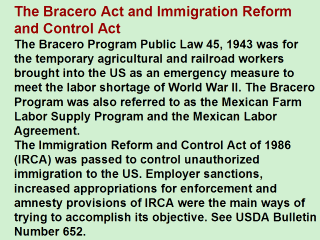| front |1 |2 |3 |4 |5 |6 |7 |8 |9 |10 |11 |12 |13 |14 |15 |16 |17 |18 |19 |20 |21 |22 |23 |24 |25 |26 |review |
 |
The
US-promoted Bracero recruitment in the 1940s and 50s oriented many Mexican
workers toward the US labor market. This reenforced a tradition of
migration, raised expectations and founded permanent US residence. Although
meant to be a temporary supply of agricultural workers, one consequence was
to create a resident population. The migration policy vascilates according
to the economic cycle and the political party. A solidified chicano vote
remains a future concern. When the US economy falters, restrictionist sentiment grows more intense. When the Mexican economy slows, this too leads to an emigration push and of course restrictive counterpunches. The IRCA invited millions of illegal immigrants out of hiding, then slammed the door shut on those who would follow. IRCA of 1986 had significant intended and unintended consequences for migrants. The US Mexican population increased during the late 1980s and early 1990s due to IRCA’s legalization provisions. Starting in 1987, about 1.7 million unauthorized migrants and an additional 1.3 million unauthorized Special Agricultural Workers (SAWs) applied for legalization under the amnesty provisions of IRCA. It imposed sanctions on employers who knowingly hire unauthorized workers. It legalized 2 million unauthorized residents. The North American Free Trade Agreement (NAFTA) was signed in 1994 by US, Mexico & Canada. Commerce not people. Mexicans thereby are paying less for food as it is much imported by the oil-dependent economy. Mexican agriculture had long been antieconomic and had subsidized prices. In the very end, failure in food production is due to lack of rainfall. Also, irrigation and other agricultural uses of energy may be prohibitive. |